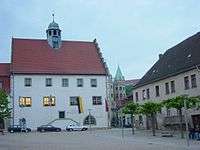Freyburg, Germany
| Freyburg | ||
|---|---|---|
 | ||
| ||
 Freyburg | ||
Location of Freyburg within Burgenlandkreis district 
 | ||
| Coordinates: 51°12′46″N 11°46′11″E / 51.21278°N 11.76972°ECoordinates: 51°12′46″N 11°46′11″E / 51.21278°N 11.76972°E | ||
| Country | Germany | |
| State | Saxony-Anhalt | |
| District | Burgenlandkreis | |
| Municipal assoc. | Unstruttal | |
| Government | ||
| • Mayor | Udo Mänicke | |
| Area | ||
| • Total | 46.57 km2 (17.98 sq mi) | |
| Population (2015-12-31)[1] | ||
| • Total | 4,735 | |
| • Density | 100/km2 (260/sq mi) | |
| Time zone | CET/CEST (UTC+1/+2) | |
| Postal codes | 06632 | |
| Dialling codes | 034464 | |
| Vehicle registration | BLK | |
| Website | www.freyburg-info.de | |
Freyburg is a town in the Burgenlandkreis district, in Saxony-Anhalt, Germany. It is situated on the river Unstrut, 9 km northwest of Hanseatic Naumburg, 63 km from Leipzig and 231 km from Berlin. It is part of the Verwaltungsgemeinschaft ("collective municipality") Unstruttal.
The town is a tourist destination, best known for its vineyards, historic town centre, superb 11th-century castle and associations with Friedrich Ludwig Jahn (founder of modern gymnastics). One of the most prosperous towns in the region, Freyburg is nicknamed 'Tuscany of the North' [2] It is the headquarters of one of the world's largest wine companies.[3]
History
The history of the town is inextricably linked to its massive hilltop fortifications, the Neuenburg Castle. The castle was built around 1090 by the Thuringian count Ludwig der Springer, securing his territory in the east, as did its sister castle Wartburg in the west.[4] The Neuenburg is five times larger than Castle Wartburg and was built in the same style, with the latter being known as the most quintessential German castle due to its associations with Martin Luther and Johann Wolfgang von Goethe, and its role in the origination of the modern German flag.[5]
Like its sister castle, the Neuenburg has also played a significant role over the centuries, hosting historical figures like King Henry I, Holy Roman Emperor Friedrich Barbarossa and the poet Heinrich von Veldeke. By the 13th century, the Neuenburg came under the control of members of the house of Wettin (now the royal family of England). Not surprisingly, Freyburg has been a strategic military prize throughout history and has been attacked by the Swedish army in the 17th century and the French army in the 19th century under Napoleon.[6]
Between 1825-1852, Freyburg was the home in exile to 18th century gymnastics educator Friedrich Ludwig Jahn. He was widely regarded as the founder of modern gymnastics and left behind the world's first gymnasium in Freyburg. He is buried in Freyburg and his memorial in the town has become a pilgrimage site for gymnasts such as Olympic champion Klaus Koeste and world champion Erika Zuchold.[7]
Wine
Freyburg is the northernmost wine growing region in Germany and Europe[8] and has a wine festival called the "Winzerfest" every year in September. One of the oldest wine growing regions in Europe, the Freyburg region has more than a thousand years of documented wine growing history.
Despite having barely 700 hectares of vineyards under cultivation, the town is the headquarters of one of the world's largest wine companies - Rotkäppchen-Mumm. The winery was founded in 1856, and by 2010, captured nearly half the market for sparkling wine in Germany and has a reported turnover of more than US$1 billion (780 million euros).[9] This Freyburg-based producer is one of the five largest producers of sparkling wine in the world, along with Spanish producer Freixenet (headquartered near Barcelona) and French producer Moët Hennessy Louis Vuitton (headquartered in Paris).
There are also other smaller wine producers in the region. Wine critics have pointed out that while there were not that many great wines from the Freyburg area, there were also very few poorly made wines. Quality across vineyards tend to be fairly consistent, ranging from average to very good. However, there are a handful of award winning wine producers that are highly rated by critics, such as Winzerhof Gussek, Weingut U.Lützkendorf and Weingut Bernhard Pawis.[10]
Freyburg can grow wine commercially unlike other regions of similar latitudes in Europe is based on the high concentration of heat-retaining calcium in the soil and a micro-climate that make it significantly warmer than nearby Berlin and Leipzig. The river Unstrut runs through it, and is home to large pike, trout, carp and beavers. In the hills surrounding the town, there are deer, wild boar, pheasant and fox. There are many working farms scattered around the region, offering a wide range of fresh and organic produce.
Personalities

Sons and daughters of the city
- Robert Hermann Schomburgk (1804-1865), natural scientist
- Moritz Richard Schomburgk (1811-1891), botanist and research traveler
- Felix Hoppe-Seyler (1825-1895), chemist and physiologist
- Ernst Neufert (1900-1986), architect, author
Personalities who have worked on the ground
- Friedrich Ludwig Jahn, (1778-1852), gymnastics educator, Turnvater Jahn
References

External links
| Wikimedia Commons has media related to Freyburg (Unstrut). |
.png)
